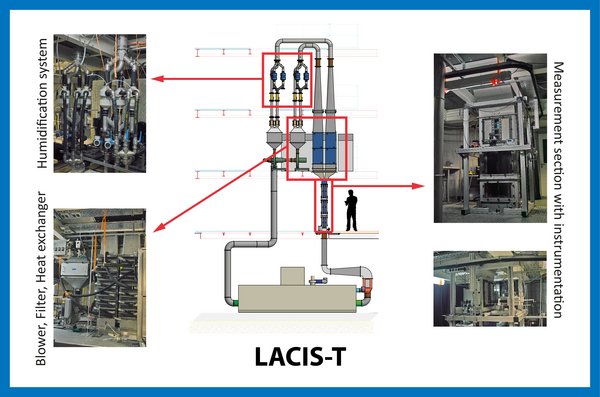
Sketch of LACIS-T in the TROPOS cloud laboratory building: © Schulz und Schulz Architekten GmbH; Ingenieurbüro Mathias Lippold, VDI; TROPOS.

The "turbulent Leipzig Aerosol Cloud Interaction Simulator" (LACIS-T) is an atmospheric simulation chamber for investigating atmospherically relevant interactions between aerosol particles and cloud droplets/ice crystals under well-defined, turbulent laboratory conditions. Investigations at LACIS aim at fundamental process understanding and are complementary to field measurements. LACIS-T was financially supported by the Leibniz-society (WGL, SAW project: SAW-2013-IfT-2).

Sketch of LACIS-T in the TROPOS cloud laboratory building: © Schulz und Schulz Architekten GmbH; Ingenieurbüro Mathias Lippold, VDI; TROPOS.
LACIS-T is a closed loop wind tunnel (Göttingen type). The air inside the system circulates continuously with a flow rate of up to 10.000 l/min. The actual measurement section is 2 m long, 80 cm wide and 20 cm deep. Cloud formation occurs via turbulent mixing of three conditioned flows (i.e. two particle-free air flows, and one aerosol flow) brought together at the inlet of the measurement section. Turbulence is thereby generated by two passive, planar grids in the particle-free air streams (approx. 5.000l/min each). The main feature is that the thermodynamic (mainly temperature (-40°C < T < 25°C) and water vapor concentration (-40°C < Td < 25°C, Td: dew point temperature)) and flow conditions of the three flows can be separately adjusted and controlled with high precision.
Inside the measurement section both particle-free air flows are turbulently mixed, resulting in the combined flow becoming locally supersaturated with respect to liquid water and/or ice. In the mixing zone of the two air flows, aerosol particles of known size, chemical composition and number are injected. Due to this setup, the influence of temperature and water vapor fluctuations, and consequently saturation fluctuations onto cloud droplet activation and heterogeneous ice formation can be studied with well-known initial and boundary conditions (see Niedermeier et al., 2020 and here). Additionally, mixing processes of cloudy and cloud-free air and associated changes in cloud particle properties are explored (STEP). State-of-the-art measurement technology is available to determine temperature, water vapor concentration, flow velocity, turbulence intensity and dissipation as well as the size distribution of cloud particles within the measurement section.
From April 2021 to March 2025, transnational access (TNA) will be offered through the EU program ATMO ACCESS. This access will take place on-site at LACIS-T (so-called "physical access") and will include scientific studies on the topic of cloud microphysics-turbulence interaction, testing of new instruments and instrument inter-comparisons under turbulent conditions, as well as training on how to perform experiments at LACIS-T including hands-on training on high-end and state-of-the-art instrumentation. Detailed information about the offered TNA services can also be found on the ATMO-ACCESS website (https://www.atmo-access.eu) and here. Already during the EU program Eurochamp 2020 (2016 - 2021) this kind of access was granted and established.
Furthermore, LACIS-T is listed as an atmospheric simulation chamber in the European research infrastructure ACTRIS with the goal to enhance the knowledge of the interaction between aerosols, clouds and turbulence (e.g., influence of turbulence on droplet formation and freezing; influence of entrainment and mixing processes on the microphysical properties of clouds) and to further establish and strengthen the position of LACIS-T as key facility in Europe for this kind of research. To achieve these goals, on the one hand, national and international collaborations (e.g. with Michigan Tech) as well as access to researchers within ACTRIS are foreseen. On the other hand, an extension of the measurement technology at LACIS-T is currently taking place within the framework of ACTRIS-D, the German contribution to the European research infrastructure ACTRIS.